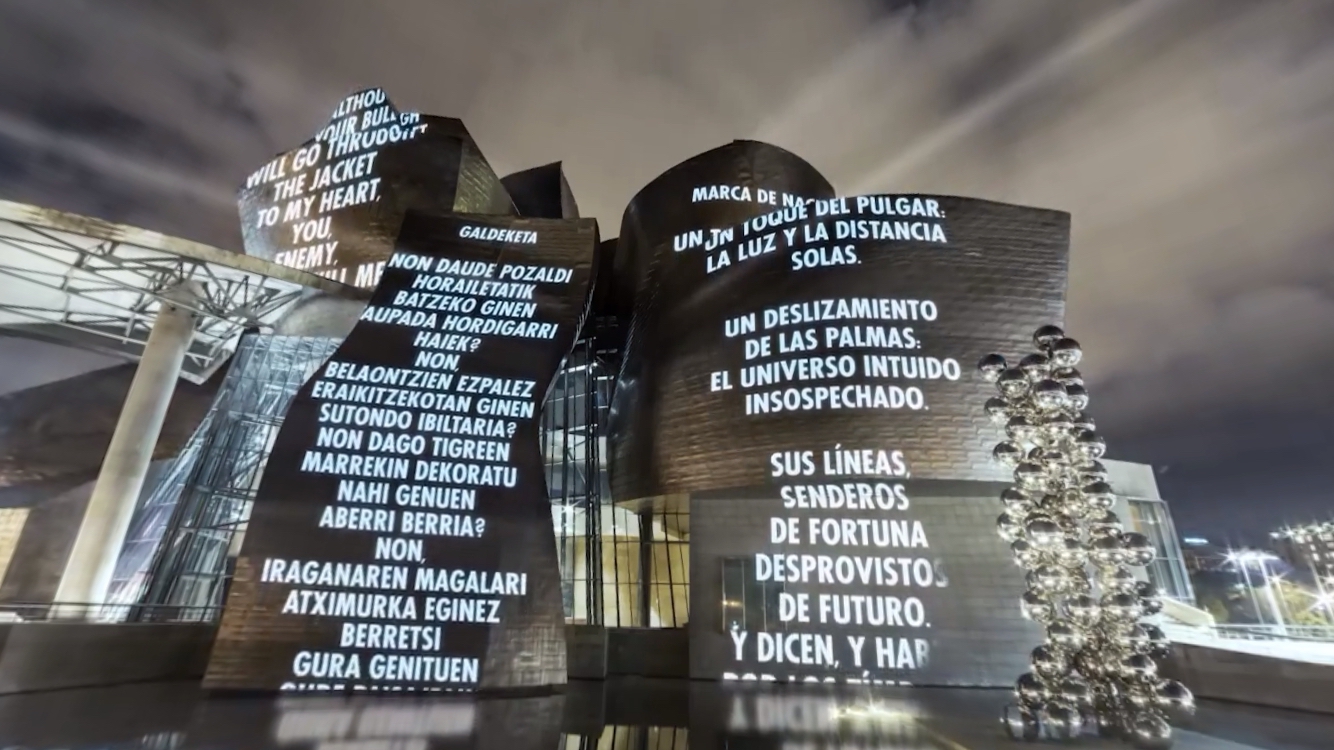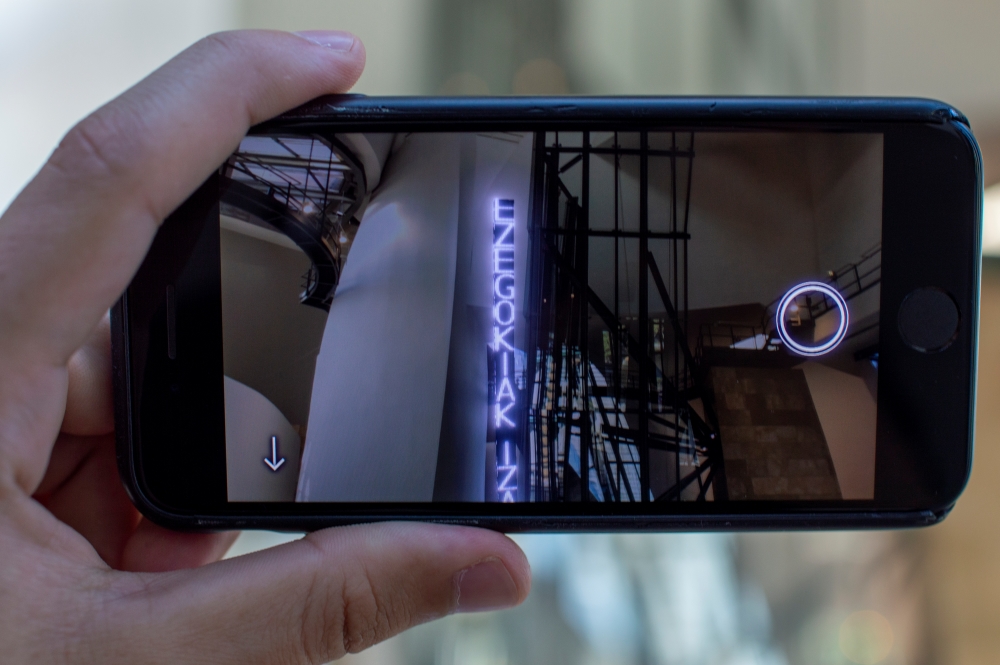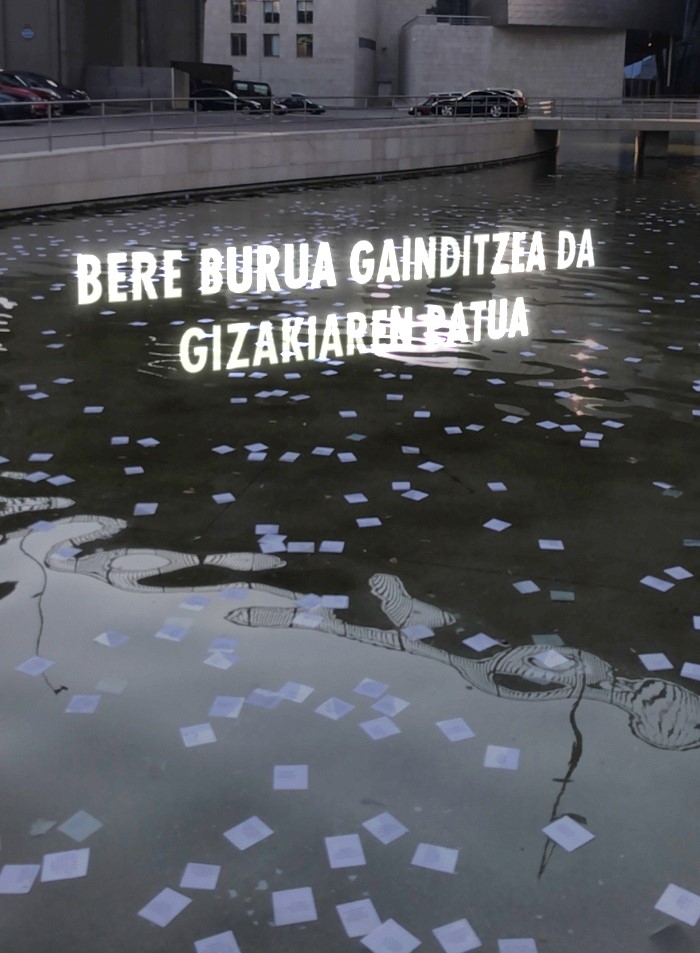
- American artist Jenny Holzer has developed three truly augmented artworks that deepen their relationship with the Guggenheim Museum in Bilbao. Holzer has built his career around words and ways of transmitting words, suggesting to viewers ways to reflect. We present some of what was suggested by the exhibition Like beauty in flames in the context of the Bilbaíno museum.

In the late 1970s they began to appear on the walls of the Manhattan district in New York (EE.UU. printed phrases in white black: “Decency is relative”, “Description is more valuable than metaphor”, “Lack of organization is a type of anesthesia”, “Freedom is a luxury, it is not a necessity”, “Hiding your motives is a disgrace”, “Eating too much is a criminal”, “Peaceful man is not necessarily a better man”, “Excess power does not surprise us”, “On the list of 1979.
These slogans appeared unsigned on the walls of the city so that the attention of the people was postponed in the meaning of the phrases and not in the author. Truisms is one of the most well-known works by artist Jenny Holzer (1950, Ohio, USA), who has since taken advantage of some of the phrases collected forty years ago in various works. Most are condensed sentences from literary and philosophical works that he read at that time, some that can be considered true; hence the title: Topics.
All sentences can be seemingly correct, at least in the eyes of one or the other. And the contradiction between sentences, or between a sentence and what you read, or small differences, concerns, is what provokes reflection. One of the objectives of the work, constant in Holzer's work, is to reflect on everyday issues through phrases and poems exposed in public.
The function of the
word The written word, the phrase, has become one of the most representative characteristics of Holzer's work. The word itself has been the path that has followed for innovation. If at first they were posters placed on the walls, then it went to the information panels, and since then it has continued experimenting with the brackets: official brass and silver plates, t-shirts, specially created LED panels, granite banks, condom wraps, giant projections...

Awareness of the message conveyed and the way to do so is complete in Holzer’s artworks. Nowadays, in addition to its own texts, it also uses other people, and especially finds work material in poems, but also in testimonies and official documents. In any case, the texts it selects are a good starting point for contemplation and reflection. It rarely gives instructions about the work, letting the viewer make links and draw conclusions. It's not hard to think of the words sculpted in a bank of red granites, or to observe enigmatic sentences that are constantly passing to earthworms, letting the mind move.
Anyone who has ever entered the Guggenheim in Bilbao is surely set to Installation for Bilbao (Bilbao Plant), created by Holzer for the museum in 1997: a handful of LED columns with text on both sides, in red before, behind blue.
The relationship between the artist and the museum in Bilbao has been close over these years, and in it you can see other works of his like engraved granite benches, of different series and times, and a four-sided LED panel with testimonies from those who lived the war in Syria. Likewise, in 2019, a significant sample of Holzer's work was made in the museum: Jenny Holzer. This is called indescribable. His work for Bilbao was prepared for the first days of the exhibition. He projected texts from 19 international poets and the Basque Country on the museum's exterior walls.
But the work Like beauty in flames, which this year has
been exhibited in the Guggenheim as in the flame, is unique. In fact, you can only see it in augmented reality through an application created for that purpose. It consists of three pieces. The first one can be seen in the court of the museum. It can be achieved by placing the access at the points of the three atrium floors. From the outside of the building you can see the other: the piece simulates the projection of some poems on the museum walls. As for the final piece, anywhere in the world, you can see phrases that appear randomly on the landscape that you want.
As for the part of the atrium, once access has been acquired, the phone should be oriented towards the center of the atrium (or device with the installed application). It appears floating in the air an artificial LED panel, similar to the panels that have become common in the work of Holzer, where you can read some of the phrases that Truisms collected forty years ago in Basque, Spanish, English and French. The artificial panel takes impossible shapes, turning up and down in the atrium, rolling, representing infinity in an instant.

However, the augmented reality LED virtual column is different from the material panels. It is linked to the place, like others, but there is no possibility to take in the hands or sit quietly in front of it. It moves, it looks like it flees. This makes it difficult to look at the text, the language of the phrase and the loose words can catch exactly. When traveling through the atrium's plants, it seems like something to think about. There's a lot of people in the museum, but there's a lot of people watching the play from the small screen on the phone. There's Like beauty in flames, but it's not, and it risks taking the trace of something that's not looking at the dancing words. The piece is suggestive by the very nature of the piece. How space occupies the work of art without occupying space, without giving time to the snake. The sensation of the viewer is contemporary, and the mediation of the mobile also singularizes the experience, while making it possible and limiting, because to some extent it interferes.
The work is entitled by a phrase taken from a poem by the Polish poet Anna Swirszczynska: “The museum is on fire. Like straw / beauty honored by male generations / is smoking. / No price / like a man's body. // A man just to take care of the museum / everything has been in the world / has been able to arrive in time. // If you survive / confirm the next generations / how beauty was dying as in beauty / flame.”
The work consists of the other two pieces. The second is located outside the museum. Remember the screening of Bilbao in 2019. Looking at the small screen, you can see a kind of simulation of this projection from different points in the museum environment. In it you can read the poem of Swirszczynsk, which also allows you to reflect on the museum. The content of the piece seems technically more onplexus, it's not just text, or a simple text container is compatible with any background plane. In this case the text and the background (museum building) go together. Therefore, on the phone there is a night image of the Guggenheim with the projected texts. It's a curious sensation of everything. Like the previous one, it's not a comfortable experience. You have to keep your hand raised in full afternoon sun to keep your phone in front of your eyes and be able to see the words that emerge on the small screen.
The third piece can be seen from anywhere. Truisms' phrases appear randomly on the screen even if the user is where they are; the artwork can be brought to any place, somehow, you only need a mobile phone. We press the button to modify the phrase and it appears again and again, among other things, a phrase in Basque: “Man’s destiny is to overcome himself.” It becomes more ironic or cynical according to the background plan that each one brings to it. There is another one in Spanish: “Alienation produces eccentric or revolutionary.”

New phrases for the collection A few months
ago the museum environment is dressed by thousands of papelites. Square papelites that carry in white several black stamps. “After titanium and works of art, job insecurity is preserved”, “Listen to the Guggenheim, the pim pam pum cleaning”, “The Guggenheim is the museum of job insecurity”...
The strike of the cleaners of the Guggenheim itself in Bilbao cannot be mentioned. At the time of writing, they have been on strike for over 80 days. In addition to the Papelites, there are also employees who protest around the museum. Every week they organize spectacular activities to turn people's attention away from titanium splendor and draw attention to its state.
The cleaning of the museum is a subcontracted service with salaries of about 600 euros per day of 20 hours. They protest against the wage gap, denounce that there is an annual gap of 8,000 euros compared to the most masculinized barrels in the feminized interior cleaning sector. The company spawns them for the time being, but they continue to fill the streets with ups and downs, which in dialogue with Holzer's works give a special result.